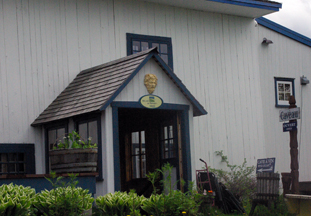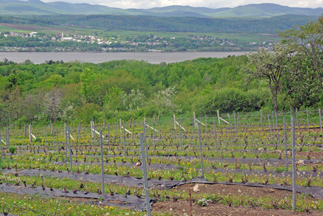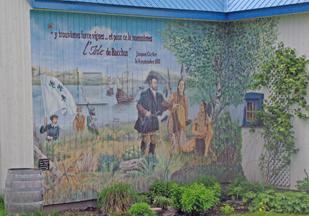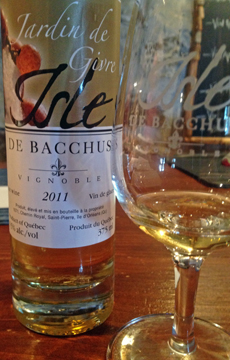Vignoble Isle de Bacchus
by
Kathy Sullivan
 Summary: Vignoble Isle de Bacchus, on Île d'Orléans in Quebec offers visitors a warm welcome in the lower level of a 1700s home. The owners of the winery planted the first vineyard on Île d'Orléans island. Views of the St. Lawrence River contrast against the nearby vineyards.
Summary: Vignoble Isle de Bacchus, on Île d'Orléans in Quebec offers visitors a warm welcome in the lower level of a 1700s home. The owners of the winery planted the first vineyard on Île d'Orléans island. Views of the St. Lawrence River contrast against the nearby vineyards.
Located on the Île d'Orléansjust a few minutes from Quebec City, Isle de Bacchus is a celebration of wine and history. Tucked around a corner, visitors will discover the tasting room in an early 1700s house. Located on the bottom level of the house, the walls are of aged stone. In a corner is the old stove with a bread oven in the wall.
 Vineyard
Vineyard
The vineyard, the first on the island, was started as an experiment in the front of the historic house where sheep had been raised. Today the vineyards consist of 50,000 vines on 11 hectares (27 acres) that include Vandal-Cliche, Geisenheim, Eona, St. Croix, Marechal Foch, Merlot, Frontenac.
The vineyard slopes downwards toward the St. Lawrence River. A buffer of trees stand between the vineyard and the river. During our late May visit, the vines were just beginning to show some growth. The proximity to the St. Lawrence River is beneficial for the vineyard. The vineyard is usually frost free from Mid-May until mid-October.
 The name Vignoble Isle de Bacchus came from Jacque Cartier who discovered many grapevines on the island. Cartier named the island Isle de Bacchus for one year until it was renamed Île d'Orléans. The winery commemorated the 375th anniversary of the arrival of Jacque Cartier on the island.
The name Vignoble Isle de Bacchus came from Jacque Cartier who discovered many grapevines on the island. Cartier named the island Isle de Bacchus for one year until it was renamed Île d'Orléans. The winery commemorated the 375th anniversary of the arrival of Jacque Cartier on the island.
A few steps away from the winery tasting room is a small terrace where visitors can enjoy a picnic lunch. Views of the scenic vineyards and St. Lawrence River can be enjoyed.
 Wines
Wines
1535 Reserve 2010, a white wine, was a blend of Eona, Geisenheim and Vandal-Cliché. 1535 was the year Cartier landed on the island. The 1535 Reserve was aged in American oak for six months. The aroma, with an oak influence, offered notes of smoke and caramel. The taste and finish had floral and caramel nuances. The finish was crisp. Le Sainte-Pierre 2011, a rosé wine, was made with 100 percent St. Croix grapes. The aroma was of light red fruit. The smooth taste offered light red berry fruit and was dry. Suggested pairings included goat cheese and spinach salads.
Village des Entre-Côtes (village between hills) 2011 was a blend of Marechal Foch, St. Croix and Mitchurinetz. The wine aged in American oak for six months. The aroma and taste offered dark fruit notes and spices, especially pepper. The wine finish had tannins with fruit yielding to spice.
Fleur de Lyse was a blend of the 1535, maple syrup and grain alcohol. This was a yellow color with a floral and citrus aroma. The 15 percent alcohol was smooth with a hint of maple syrup. Jardin de Gevse (garden of frost) was a blend of Vidal and Geisenheim. The light yellow wine offered dried fruits and floral notes. The taste was smooth with apricot and tropical fruit nuances. The crispy finish cut the sweetness of the wine. Considered a fun wine by the winery, the Kir de Île was a light pink/salmon colored wine that offered tasty fruit notes. A suggestion was made to add a few frozen grapes to a glass of The Kir.
When visiting Vignoble Isle de Bacchus, be sure to notice the authentic historic tasting room and ask about the connection to Jacques Cartier.
Vignoble Isle de Bacchus
1071 Royal Way
Saint Pierre d'Orléans Island, Quebec, Canada G0A 4E0
Article written June 2013
Visit this Winery/vineyard travel agency and Canada winery that partner with Wine Trail Traveler.
 |
||
| In Vino Veritas Travel Agency |
